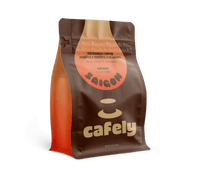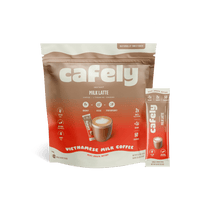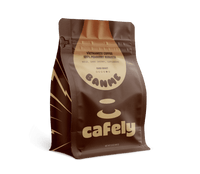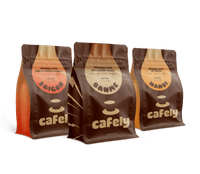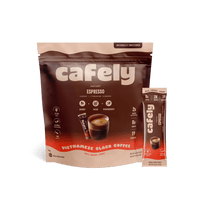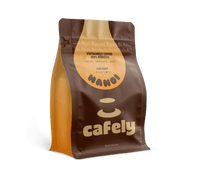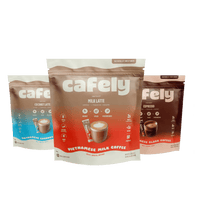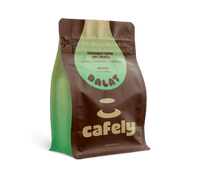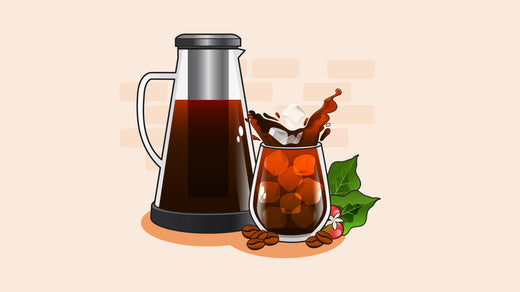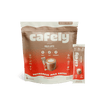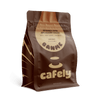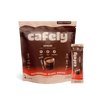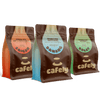It’s pretty disappointing to remember your cup of hot coffee hours after pouring it… only to find it has gone cold.
A cold brew, on the other hand, is a delightfully refreshing beverage that offers flavors and textures you won’t experience with other brewing methods. It's meant to be consumed cold and delivers more flavor and more caffeine than typical hot coffee.
Cold brew coffee is distinct from iced coffee (which is hot coffee that you chill after brewing). Cold brew involves steeping coffee grounds in cold or room-temperature water for between 12 and 36 hours.
Whether you are cooling off on a hot afternoon or grabbing a cup first thing in the morning, cold brew coffee is a smooth and refreshing beverage any time of the day.
What To Look For When Buying Coffee For Cold Brew:
- Low Acid Coffees — Coldbrew already extracts less acid than other brewing methods, but most people prefer the smooth taste of lower acid arabicas when brewing cold brew coffee.
- Light or Medium Roasts — All roasts work great in a cold brew, but the gentle brewing method of cold brew tends to extract more of the complex flavors in lighter roast beans.
- High-Quality Beans — The quality of your beans directly impacts the flavor of your cold brew. Look for fresh, specialty-grade coffee beans from reputable sources to ensure the best results. Single-origin coffees are an excellent choice for exploring distinct flavor profiles.
- Coarse Grind — A coarse grind is essential for cold brew to prevent over-extraction and bitterness. If you're grinding at home, aim for a consistency similar to coarse sea salt. Pre-ground coffee labeled for cold brew is also a convenient option.
- Freshness Matters — Coffee loses its flavor over time, so always check the roast date when buying beans. Ideally, use beans roasted within the last 2–4 weeks to ensure peak freshness and vibrant flavor.
- Flavor Profiles — Choose beans with tasting notes that align with your preferences. For example, if you enjoy fruity and floral notes, opt for beans from regions like Ethiopia. For chocolaty or nutty flavors, try coffees from Central or South America.
- Experiment and Blend — Don’t be afraid to mix different beans or roasts to create your unique cold brew blend. Combining a bold dark roast with a bright medium roast can balance flavors and add depth to your brew.
Top 4 Coffees to Use For Your Next Cold Brew
Wondering which coffee makes the best cold brew? Cafely has got you covered with these blends:

1. DaNang 50/50 Robusta & Arabica Beans
An incredible blend of 50% robusta and 50% arabica beans, DaNang coffee is a balanced medium-dark roast.
This coffee boasts a smooth finish with enhanced notes of hazelnut, maple syrup, and citrus.
DaNang coffee has a naturally low acidity and crafts a rich, full-bodied cold brew for any occasion.
2. DaLat 100% Arabica Beans
Many coffee drinkers are already familiar with 100% arabica beans, making DaLat coffee an excellent choice for all, especially cold brewing newbies.
It has a smooth finish with a mild fruity flavor, enhanced with notes of caramel and blackberry. This dark roast has a low acidity for an excellent and refreshing cold brew.
3. HaNoi 100% Robusta Beans
With 100% robusta beans, HaNoi blend offers an intense, full-bodied cold brew with explosive earthy notes of chocolate.
HaNoi’s 100% Vietnamese-grown beans are as authentic as the capital city itself—and boast a strong dark roast.
4. BanMe 100% Peaberry Coffee
This is Cafely’s strongest, most caffeinated coffee.
With 100% shade-grown peaberry robusta beans, BanMe coffee adds bold notes of cherry, chocolate, and spice to your cold brew with an intense caffeine boost.
Tips For Choosing the Best Coffee for Cold Brew
When selecting the best coffee for cold brewing, you want to consider the type of bean (and its origin), the roast, and the grind size. But you can choose with confidence with our comprehensive guide to cold brew coffee:
1. Arabica vs. Robusta For Cold Brew
When most people think of coffee, freshly roasted arabica often comes to mind. Arabica beans account for nearly 60% of the coffee people consume around the world [1], and most big-name coffee shops use these beans.
In the past, robusta beans had a bad rap as a low-quality mass-produced coffee. But Cafely and others are changing that by offering only the finest robusta beans for a strong, pleasant taste.
If you’re not sure how to choose between arabica and robusta beans, check out this guide to how each enhances your cold brew.
Robusta Beans
Mostly hailing from southeast Asia and the western coast of Africa, robusta beans bring these characteristics to your cold brew:
- Strong, bold taste
- Pleasant bitterness with 60% less sugar
- Low acidity
- High caffeine (nearly double that of arabica)
- Nutty, earthy notes
- Less fat
- High antioxidants
Since cold brewing extracts the flavors without the bitterness, robusta beans are an excellent, strong flavored choice for cold brew coffee.
Not only that, robusta beans are an environmentally sustainable choice. Robusta plants produce higher yields with fewer resources, meaning farmers use less water to grow them. Robusta coffee plants also have greater disease resistance, which means fewer chemicals, and grow at a broader temperature range, making them a strong solution for climate change.
Arabica Beans
Typically grown in Latin America and East Africa, arabica beans are popular for their:
- Smooth texture
- Lower caffeine content
- High acidity
- Minimal bitterness
- Sweetness
- Delicate flavor, often with fruity notes
Robusta-Arabica Blends
But why choose one or the other? Cafely offers many arabica-robusta blends for a balanced cold brew [2]. With these blends, you can enjoy:
- Arabica’s smoothness with robusta’s body and foam
- The delicate flavor of arabica with robusta’s strength
- The sweetness of arabica and the pleasant bitterness of robusta
2. Coffee Origins For Cold Brew

Brazil might be the largest coffee producer in the world, but Vietnam is a close second [3]. Not only that, Vietnam produces 35% of the world’s robusta beans [4] and the coffee industry there is rapidly growing every year.
Vietnam offers incredible benefits to the world of coffee, including:
- Perfect climate for growing coffee, with abundant rainfall and sunshine
- Rich volcanic soil
- Ability to face the threat of climate change
- An established coffee culture
- High-quality robusta beans
- Huge increase in organic coffee production and innovative farming techniques
Cafely sources its beans from the coffee-growing center of Vietnam and prioritizes fair-trade, safe work environments, and sustainable practices to bring the highest-quality hand-picked beans to your cold brew and beyond.
3. Selecting The Best Roast Level For Cold Brew
When it comes to roasts, cold brew is more forgiving than many other brewing methods. While extraction is still vital to a good cup, the sustained steeping slowly draws out the bean’s flavors and characteristics without over-extracting.
Each roast level creates its own distinct cup of cold brew:
- Light Roast: Sometimes called blonde, light roasts may lack the characteristic “roasted” flavor, but the light, muted tones create an almost tea-like beverage.
- Medium and Medium-Dark: For many, this is the ideal roast for cold brew. It brings out the rich smoothness with nutty or chocolatey notes and offers a balance between acidity, sweetness, and flavor.
- Dark Roast: Dark roast works well for cold brew because it delivers a consistent flavor. The strong, rich drink is excellent with milk or sweeteners, and it’s hard to go wrong with a dark roast cold brew.
Remember, cold brewing brings different flavors and characteristics out of the beans, so your favorite hot brew might not hit the spot for cold brewing. Now is the perfect time to experiment with new coffees and roasts to see which one suits your cold beverage the best!
4. The Best Grind Size For Cold Brew Coffee
How you grind your coffee for cold brew is almost as important as which beans and roast you use. In most situations, a coarse grind creates a superior brew because:
- Water easily penetrates the large grinds, avoiding dry clumps and allowing the coffee to steep more fully.
- Coarse grinds ensure a slower extraction, which prevents bitterness.
- Coarse grinds are easier to filter out after brewing.
For best results, grind your coffee just before brewing to ensure the highest level of freshness and flavor. When buying pre-ground coffee, look for coarse ground or let the roastery know you are using it for cold brew so they can grind accordingly.
How to Prepare Cold Brew Coffee at Home

Now that you have that perfect coffee beans, you’re ready to make a cold brew beverage with these simple steps:
- Place your coffee grounds in a mason jar (alternatively, you can place your grounds in a reusable coffee filter, nut milk bag, or French press so you won’t have to strain it afterward).
- Add water to your jar and stir to prevent the grounds from clumping. The ideal water temperature for cold brewing is 37.4–68ºF (3–20ºC).
- Aim for a coffee-to-water ratio of 1:8. You can also make a cold brew concentrate with a ratio of 1:4 that you can dilute later with milk or water.
- Let the brew sit in your fridge (some people like to leave it on their counter) for 12 to 24 hours.
- Strain your cold brew by pouring it through a coffee filter or a double layer of cheesecloth inside a fine sieve (you can even use a lint-free kitchen towel).
- Play barista and prepare your cold brew to your preferences, then enjoy.
Follow this basic recipe to create a cold brew at home. Then, experiment with the water temperature, coffee ratio, and brew times until you land on the perfect balance for your coffee.
Adding More Flavor to Your Cold Brew
Want even more from your cold brew? Try adding some of these ingredients during brewing for a customized (and delicious) beverage:
- Vanilla
- Cinnamon sticks
- Chocolate
- Citrus
Once you’ve steeped your coffee, you can combine it with your preferred sweetener (sugar, honey, maple syrup, etc.), milk or cream (try a plant-based option for a healthier brew), or sweetened condensed milk for an authentic Vietnamese coffee.
Storing Cold Brew Coffee
After you strain your coffee, pour it into an airtight container (mason jars work well) and store it in your fridge for up to a week.
FAQs: Making the Best Cold Brew at Home

1. What is the best roast for cold brew coffee?
Medium roasts are generally the best roast for cold brew coffee. They create a perfect balance between acidity and sweetness and have a rich, smooth flavor. Cold brewing also brings out the nutty and chocolatey notes of the medium roasts.
That being said, you can use any roast in your cold brew. Light roasts create a muted tea-like beverage, and dark roasts produce a consistently delicious coffee.
2. Should I use pre-ground coffee to make my cold brew?
Absolutely! Coffee experts recommend using freshly ground coffee when making cold brew. For best results, use a coarse grind to bring out the most flavor and avoid over-extraction
3. How long should I let cold brew coffee steep?
In most cases, you want to let your cold brew steep for between 12 to 24 hours. However, many factors affect this, such as water temperature, coffee-to-water ratio, and even the type of coffee you use.
The longer you let your cold brew steep, the stronger your coffee will be.
4. Is cold brew stronger than regular coffee?
That depends on how strong you make your cold brew. Depending on how much water you steep your beans in, you can make a cold brew concentrate that is significantly stronger than conventional coffee and requires dilution, or you can make a balanced cold brew with a similar strength and caffeine content as a cup of regular coffee.
5. Can cold brew coffee go bad? How long will cold brew last in the fridge?
You should store cold brew in the fridge in an airtight container and consume it within 7 days. If you add milk or cream to your brew, you should use it within 2 to 3 days.
6. What is the best coffee-to-water ratio when making a cold brew?
In most cases, a 1:8 coffee-to-water ratio is common for cold brew, and you can drink it straight. However, some coffee drinkers might find this a bit strong and prefer to combine ¾ cup of cold brew with about ¼ to ½ cup of milk, water, or ice.
You can also make a cold brew concentrate with a coffee-to-water ratio of around 1:4, which will require more dilution.
7. What should I do if my cold brew is bitter and acidic?
Bitter, acidic cold brews usually happen due to long brew times, finely ground coffee, or a lighter roast. If your cold brew is too acidic, switch to a darker roast with a coarse grind and reduce your steeping times.
8. How should I store my cold brew?
Store cold brew coffee in a glass or BPA-free plastic container in the fridge. Make sure the container is airtight to maintain freshness and prevent the coffee from picking up unwanted flavors from the fridge.
9. What is the best type of bean for cold brew coffee?
There is no one-size-fits-all bean that is best for cold brewing. Robusta beans provide a strong flavor, while arabica coffees add a nuanced richness. Robusta-arabica blends are also very popular for cold brewing as they combine the best of both worlds in every delicious cup.
10. What type of water should I use for cold brew?
Filtered water is best for brewing any coffee, including cold brew. The minerals and chemicals in tap water can affect the extraction process.
Water temperature is also very important for cold brews. The water should be between 37.4 and 68ºF (3 and 20ºC) for best results.
References
- December 2023 - Coffee Report and Outlook. (n.d.).
- Geissy de Azevedo Mendes. (2024, January 3). Determination of Arabica and robusta species in blends of roasted coffee by mid-infrared spectroscopy in association with mixture design. Food Chemistry Advances.
- Walton, J. (n.d.). The 5 countries that produce the most coffee. Investopedia.
- Coffee: World markets and trade. (n.d.).
